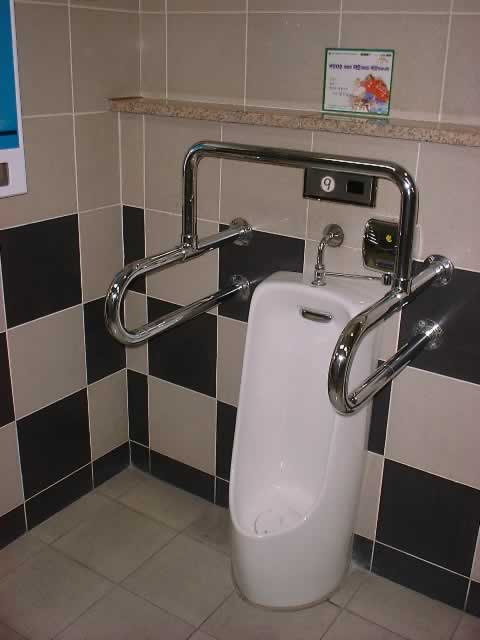
Rubbernecker took this first photo at the Panmunjeom Visitor Center in the DMZ in 2002. The Visitor Center is open only to organized tours of pre-screened and well-dressed foreign tourists.
Kevin Sullivan of the Washington Post writes: "Panmunjeom is the "truce village" that straddles the border between North Korea and South Korea in the middle of the Demilitarized Zone that has split this peninsula since the Korean War ended in 1953. The DMZ is probably the most fortified border on Earth, with more than a million soldiers facing each other with enough artillery to obliterate each other in a matter of hours. Tension constantly runs high here -- more than 50 Americans, 1,000 South Koreans and countless North Koreans have died in skirmishes along the DMZ in the past 40 years, including one recently. The DMZ is dotted with land mines and razor wire and concrete tank bunkers and Communist soldiers dug into mountainsides behind cast-iron "blast doors" to protect them against bombs dropped from American B-52s.
"...Every year, about 180,000 tourists are bused up from Seoul, 30 miles to the south, to spend a day in the clean air and wide open spaces of the last flashpoint of the Cold War... As soon as your tour bus leaves Seoul, you start to get the idea that things are a little different here. "Freedom Road," the only way to Panmunjom, is a major divided highway that is about 12 lanes across in some places. The median strip is massive and flat, just right for a wave of tanks and artillery to head north to repel an invasion. Those odd little structures up in almost every hill? Yup, those are machine gun emplacements. And so are those piles of sandbags in the median strip.
"The road stretches along the banks of the Imjin River, which is lined with one continuous eight-foot fence covered with razor wire and dotted with hundreds of military watch posts, all manned by a solitary soldier. The river itself is filled with nets and spikes and other obstacles to prevent North Korean soldiers or vessels from coming south. Huge lighted signs bearing Korean letters face the North Korean side of the river, touting "Freedom" and "Democracy."
"At Imjingak, the last village before the DMZ, buses line up next to a large display of tanks and planes and other equipment used in the Korean War. The buses must wait for permission to pass over a one-lane bridge, the only way to Panmunjom. Soldiers inspect the bus, and clear it to drive the last couple of miles to the DMZ. Along the way, the bus passes under several concrete structures that appear to have no purpose. These are tank traps, which can be collapsed with dynamite to prevent enemy tanks from rumbling south...
"The green hills and vast expanses of the DMZ are filled with rare birds and more than 140 varieties of wildlife. Because the 2 1/2-mile-wide DMZ has hardly been touched by humans in almost 50 years, it has become one of Asia's great wildlife sanctuaries.
"There are two heavily guarded villages in the DMZ, one in the north and one in the south, which face each other across the minefields. They are visible to tourists, but off-limits for visits. The southern village, Taesongdong, is home to 237 farmers; life is dangerous, but they don't have to pay taxes and they get great prices for their novel produce. The northern village, Kijongdong, looks modern enough, but if you squint through your binoculars, you'll see that the buildings don't even have glass in the windows. It's a lie, a huge Potemkin village designed to give North Korea the appearance of modernity..."